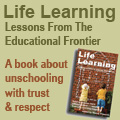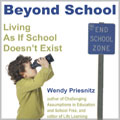|

Mental Disorder or Survival Mechanism?
What we today label as problem behaviors can be seen as ancient traits that have helped kids adapt for generations.
By Enrico Gnaulati
Shortly after my son’s twelve-year-old birthday, we hopped in the car together and took a jaunt to the Spider Pavilion on the south lawn of the Los Angeles Museum of Natural History. I had a hidden agenda for going. Since an early age, Marcello was prone to become emotionally undone at the sight of spiders. It was seriously interfering with him completing the chore my wife and I had added on his twelfth birthday: taking out the trash. He complained bitterly that there were spiders in the garage where the trash cans were kept and that this was an unfair chore. I, miffed, assumed this to be a ploy to get out of performing a family duty. No son of mine was going to shirk his chores! The test, and possible cure, would happen at the Spider Pavilion. Marcello stood back from, but still ogled, the Brazilian tarantula housed in a brick-size, thick-glass container. However, when we parted the plastic curtain flaps to enter the garden where spiders were dangling freely from myriad leggy plants and wooden rafters, Marcello became petrified and scurried to the exit. To ask him to shake it off and return would have been the equivalent of asking a person in the throngs of a seizure to put their tongue back in their mouth.
Why are so many kids deathly afraid of spiders, snakes, the dark, open spaces, enclosed spaces, and during infancy, strangers, and sudden departures by parents? Should they not be more afraid of guns, cars, saturated fats, and cigarettes – real potential modern sources of mortal harm? Evolutionary psychologists would say these fears are more innate and carried huge adaptive value in ancestral environments.
Dr. Robin Fox, best known for founding the anthropology department at Rutgers University, has written widely on how our biosocial make-up as humans is designed to respond best to hunter-gatherer conditions that existed for over ninety-five percent of human history. Not our contemporary automobile filled, crowded, noisy, artificially-lit, city life. In fact, many human characteristics that are currently classified as psychiatric disorders have helped us survive and cope as a species.
Take ADHD. Thom Hartmann, the US radio host, caused a mild stir some years ago with his hunter vs. farmer theory of ADHD. In a nutshell, he proposed that ADHD traits such as distractibility, impulsivity, and aggressiveness bolstered the survival of pre-agricultural humans. Hunters “think visually,” he explained, “and if you see a flash in the darkness, or an object move from the corner of your eye, it is likely potential food or a predator.” Restlessness, constant visual scanning, and being amped up for quick and aggressive action happen to be attributes of fine hunters. If Ritalin had been around 150,000 years ago and taken in mass quantities, our survival as a species might have been in question. Traits such as patience and a flare for organizing and planning are more becoming of farmers. ADHD children, Hartmann resolved, had ancestors with these hunter-enhancing traits in abundance. By implication, ADHD children do not have a mental disorder but are accidently endowed by Nature with traits of their ancestors that make them good hunters, but not particularly adept at sitting for long periods of time in a chalk-and-talk classroom.
The notion that ADHD produces better hunters is backed up by genetic science. A few years ago, Dan Eisenberg, an anthropology graduate student from Northwestern University, curried favor with various nomadic and recently settled Ariaal tribesmen in Kenya and drew their blood. He discovered that the tribesmen with the DRD4 gene, associated with ADHD, were more physically nourished in the nomadic population, but less so in the settled one. It turns out that being ADHD in actuality gives you a leg up under nomadic conditions when you have to forage and hunt but act as a hindrance when you have to slow down and plow the soil.
ADHD traits might make kids effective hunters, but the modern classroom is surely no African Savannah. What is the solution? At the very least, it seems to me, during periods of the day all young children, and those manifesting ADHD traits in particular, need to have access to open green spaces and be given permission to run wild. This is no romantic proposition. Professors Andrea Faber Taylor, Frances Kuo and William C. Sullivan, professors at the Human-Environment Research Laboratory at the University of Illinois, have shown how ADHD children can undergo enhancements in attention and concentration after being able to romp around in outdoor, green spaces and places. Their report “Coping with ADD: The Surprising Connection tp Green Play Settings” was published in the journal Environment and Behavior 33 (2001).
We should not be shocked when on the grassy knolls our ADHD-hunter type kid’s pretend play gravitates toward chasing and being chased, as well as succeeding at and eluding capture.
Anxiety also is a human trait that has offered and still offers people an adaptive edge. We may be endowed by Nature to be irrationally anxious, to see danger where it does not exist, until the evidence is to the contrary, rather than the reverse. It is easy to forget how down through history catastrophic loss due to disease, war, famine, and predatory and climatic events was a way of life. As recently as the Middle Ages, one in five women died in childbirth. Perinatal infant death rates were about the same. The bubonic plague in the fourteenth century wiped out an estimated seventy-five million people, give or take. The influenza epidemic of 1918-19 killed off more than the Great War—an estimated twenty to forty million. The average life expectancy until the early twentieth century hovered around age forty. In classical Greece and Rome, you were lucky to live until you were thirty.
Worrying about and anticipating the worst made it less painful when it was more highly likely to happen. Now, our brains are designed with this protective anticipate-danger response, even though, in actuality, the probability of catastrophic loss is far less.
For kids, psychological health and well-being does not entail an anxiety-free state of mind. In ancient environments, an unanxious kid was at risk for serious danger. Better to automatically interpret that a twig blown by the wind was possibly a poisonous spider and flee, than to idly stand around during one unfortunate moment and be mortally bitten. Being psycho-physiologically prepared for danger is always preferable to being unprepared. This anxious energy exists in all kids, in some more than others. When we view anxiety as written into the human genome in this way, it should make us more tolerant of and patient with kids who worry about what lurks in the dark, what physical harm might (but probably not) be due to weird bodily sensations, how being away from the protective presence of loved ones during times of perceived danger can be highly upsetting, and how actual and imagined creepy-crawly things send them into a frenzy.
Rather than talk about mental disorders in kids, as if they embody some disease entity, we always need to consider how kids are put in a state of dis-ease by environmental conditions they encounter. Educational practices and family lifestyles that stress kids by putting them well outside their cognitive mastery-zones and emotional comfort-zones can make normal human traits and behaviors appear problematic.
Sometimes, even small changes in a kid’s environment can have a big pay off. We tend to lose sight of how environmentally sensitive kids are, especially younger ones. On any number of occasions in my practice over the years, I have witnessed how an anxious or ADHD-like kid can be transformed by seemingly ordinary changes to his or her life situation—parents declaring a renewed commitment to be more predictable in their availability, a change of teacher, a different school placement, signing up for a sport, a reduced homework load, a summer abroad, a front-of-the-class seating arrangement, a month living away from home with an even-tempered aunt, or any of a host of other everyday steps.
An evolutionary perspective on children’s “problem behavior,” funnily enough, should ease the guilty conscience of any parent who believes they’re all to blame for their kid’s difficulties. There are always ancient causes for a kid’s ADHD or anxiety built into the human genome. We have our ancestors to blame, or rather to credit! Calling ADHD behaviors and anxious traits a form of a disease is extremely disrespectful to our ancient ancestors who got better and better over the millennia honing their ADHD behaviors to take down big game, and anxiously anticipate danger, so those that came after them had more of a shot at survival.
Having this profoundly historical perspective makes me sit back and smile when parents come to me in my office and say, “I think my way of parenting has harmed my kid.”
Enrico Gnaulati is a psychologist in Pasadena, California. In his book, Emotion-Regulating Play Therapy with ADHD Children: Staying with Playing, he is critical of medical approaches to the sort of behavior that gets labeled ADHD in children. Instead, he views ADHD phenomenon as rooted in children’s difficulties containing and expressing intense emotion, and he offers a model of active play therapy to healthfully intervene. In his book, Back to Normal: Common-Sense Explanations for Kids’ ADHD, Bi-polar, and Autistic-Like Behavior, he strives to lay out the normal human meanings, motives, and developmental glitches behind kids’ troubled and troubling behavior. This article, published in 2012, is based on that book.
Copyright © Life Media
Privacy Policy
  
  

|

